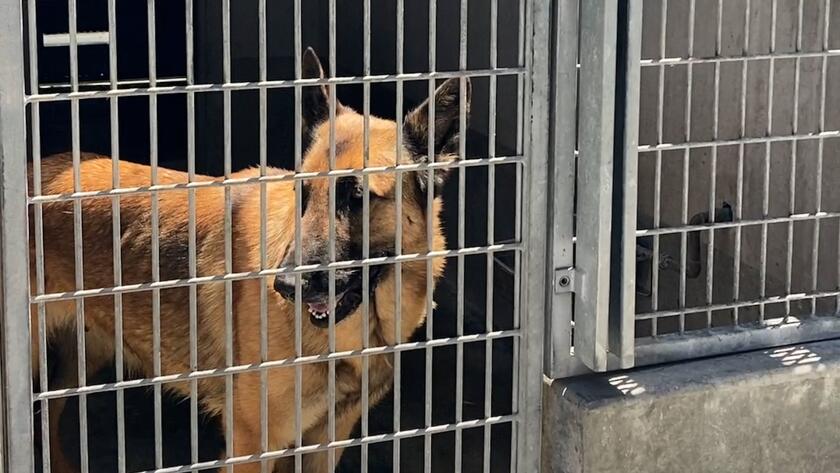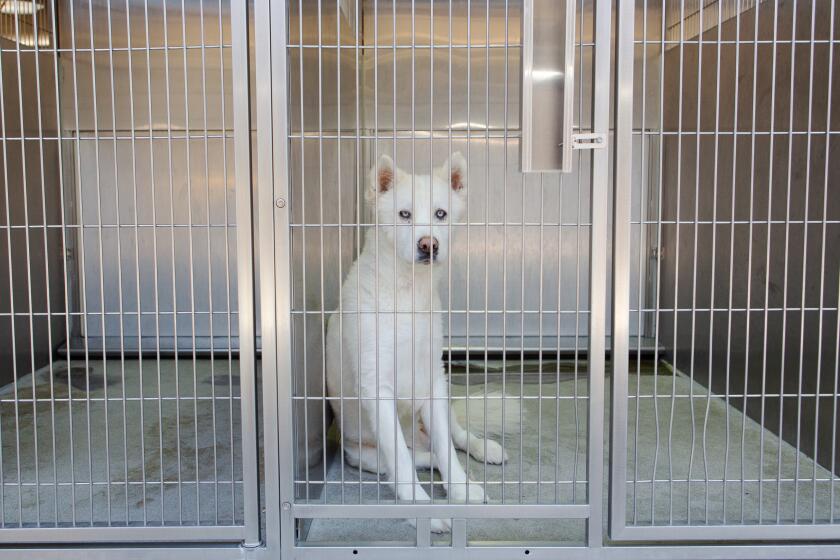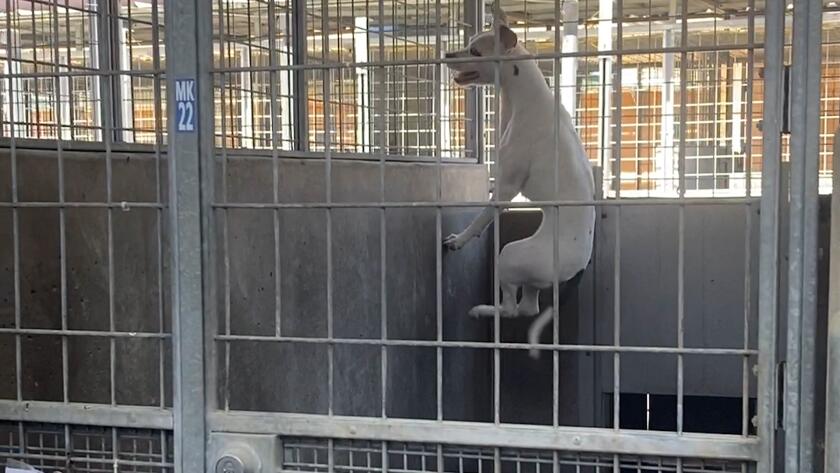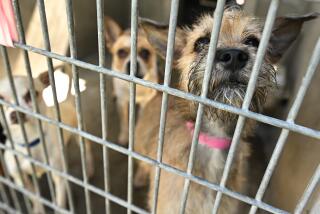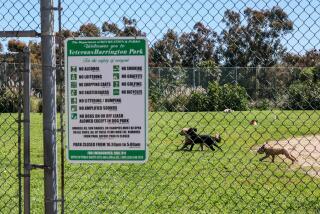‘It’s inhumane’: Dogs at L.A. animal shelters go weeks or months without being walked
Flora, a five-year-old dog was going for a walk. She hadn’t been taken out of her kennel for a walk in more than three weeks.
Flora barked loudly and shimmied back and forth in her kennel in South Los Angeles as a volunteer approached holding a rope.
The 5-year-old German shepherd hadn’t been taken out of her kennel for a walk by volunteers in 25 days, according to the volunteers’ database.
Dogs spend weeks or months inside their kennels without a break at Chesterfield Square Animal Services Center, the city’s most crowded shelter. Dogs can go more than a week without being walked at other city shelters, according to volunteers.
Dogs involved in legal cases may not leave their kennels for months.
The confinement is the result of longstanding practices at Los Angeles Animal Services, critics say. The department largely relies on unpaid volunteers, rather than city employees, to walk and exercise dogs — a system that’s being stressed as more dogs come in.
At the same time, an overcrowding crisis and disagreements over what kind of care the dogs should get is roiling the department. An employee staffing shortage is also hurting operations.
Anger over the dogs’ treatment has burst into public view in recent months.
People who want to relinquish their dogs or cats must have an appointment. Shelter workers then assess whether they can help the pet stay with its owner.
Volunteers post photos of dogs on social media that they say haven’t been out in months. At meetings of the Animal Services Commission, which is made up of appointees of Mayor Eric Garcetti, members of the public call in to urge that dogs be allowed to get out.
Two top staffers left the department this year, with one telling The Times that he left out of frustration over the animals’ welfare. The department is also on its third top executive in the last year and a half.
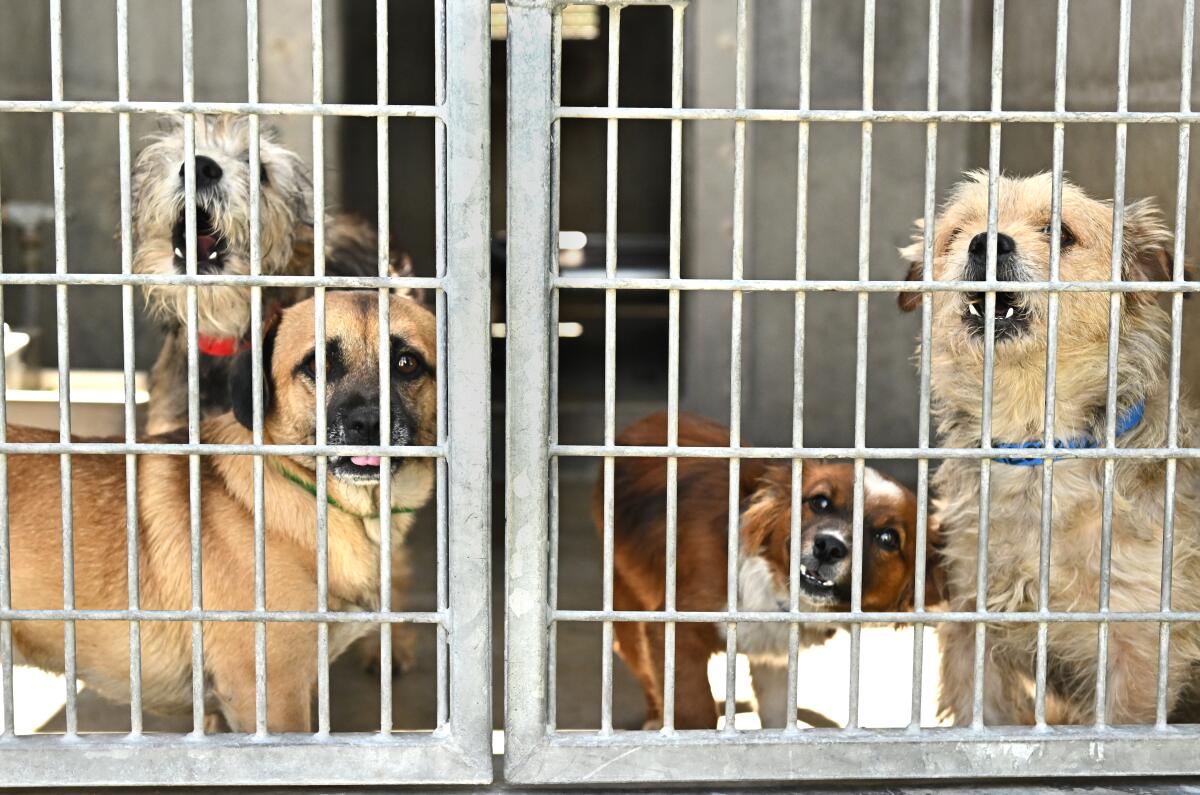
Annette Ramirez, the interim general manager at Animal Services, acknowledged during a tour of the South L.A. shelter that some dogs aren’t walked for weeks or months.

Subscribers get exclusive access to this story
We’re offering L.A. Times subscribers special access to our best journalism. Thank you for your support.
Explore more Subscriber Exclusive content.
”Our requirement is to provide them with food, water and a clean place,” Ramirez said. “We do rely on the volunteers to provide the enrichment and exercise and walks.
“As you can imagine, 300 animals,” Ramirez said, referring to the dogs at the South L.A. shelter. “It would take a lot of volunteers to do that.”
She urged the public to help out by adopting and fostering animals.
Critics say the shelters’ conditions raise questions about the city’s system of using hundreds of unpaid volunteers rather than funding more animal care in the city budget.
There are more volunteers walking dogs and bringing them to the shelters’ play yards this year — work that is physically demanding — compared with 2021, but volunteers said they still can’t keep up.
Dogs bark and jump in their kennels at a city animal shelter in Lincoln Heights.
Financial and housing stresses are driving owners to surrender pets, and the city took in 30% more dogs through May of this year than in the same period last year, according to the department. The department last month declared that it was facing a kennel space “crisis.”
In May, a staffer at the city’s San Pedro shelter emailed supervisors, begging for help. Dogs were being housed in shower stalls and wildlife cages, kennels and cages couldn’t be safely cleaned, and animals were being turned away, the staffer wrote in the email.
“I had a elderly woman trying to surrender her two pitbulls that she was living in her car with,” the staffer wrote. “I explained to her that we had nowhere to house them and she began to cry and tell me that she would hang on to them a bit longer.”
The conditions at the shelters are a contrast to 2020, when the department temporarily closed some facilities for COVID-related reasons. The number of animals coming in and adoptions dropped.
During The Times’ tour with Ramirez in South L.A., a thin gray dog jumped and spun around in the kennel — a sign of anxiety, according to experts.
“These are dogs that need to get out,” Ramirez said. “These are dogs that can’t live in a kennel environment. They need to get adopted. They need to be pulled by a rescue group.”
Former Animal Services supervisor Thomas Kalinowski, who left the department earlier this year and now works for another animal services agency, said that he was frustrated by the conditions and that there was little urgency to get the animals fostered or adopted.
“The longer they are confined and isolated, it’s detrimental to their emotional and mental well-being,” said Kalinowski, a former animal care technician supervisor and former acting district supervisor of life-saving. “It’s inhumane not to walk the dogs, not to give them enrichment.”
Animal Services spokesperson Agnes Sibal declined to respond to Kalinowski’s criticisms. Sibal didn’t respond when asked about the San Pedro shelter worker’s email.
Garcetti spokesman Harrison Wollman said that the mayor “takes the health and safety of our sheltered animals very seriously and recognizes that the current conditions at our shelters are inconsistent with the high standards he sets for animal welfare.”
City Councilmember Paul Koretz, chair of the committee that oversees animal issues, said he is scheduling an emergency public meeting next week to discuss the “urgent operational issues” at the shelters.
“I am increasingly concerned about the serious challenges that the shelters are facing,” Koretz said.
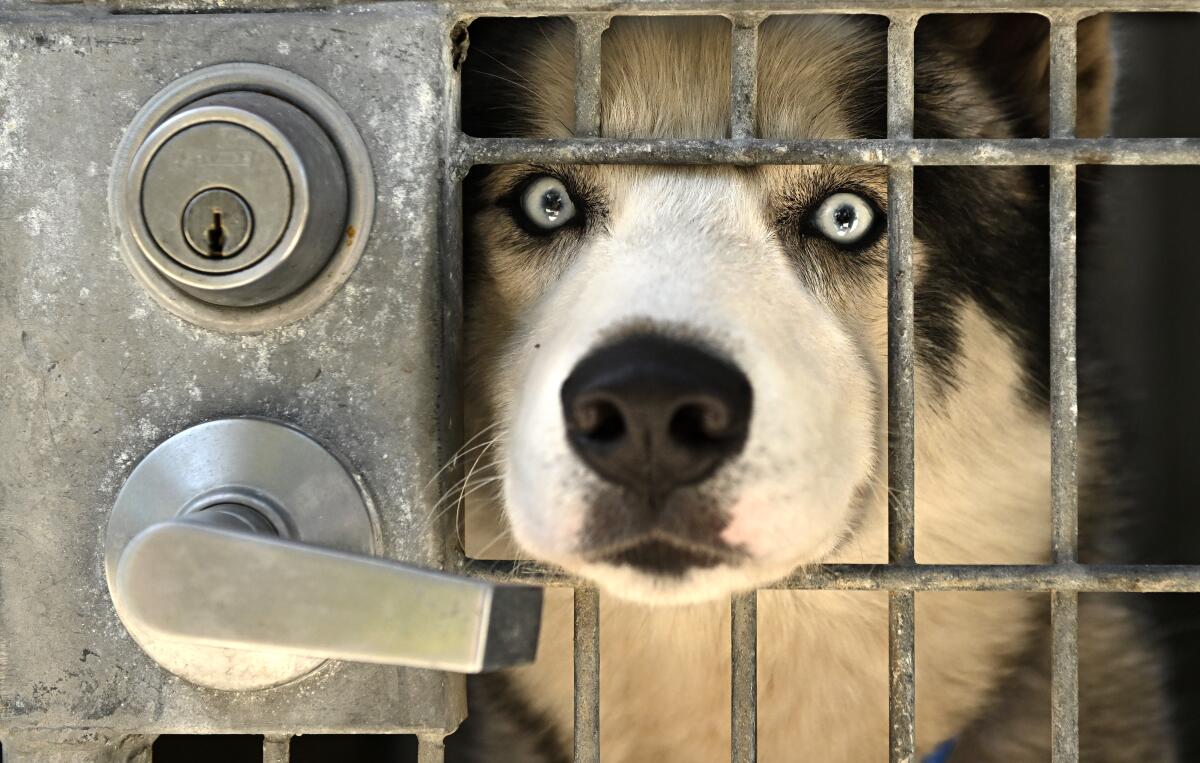
Volunteer Tom Kiesche, whose Instagram page chronicles his work at the city’s Lincoln Heights shelter, posted several days ago that he was taking out dogs that hadn’t been exercised since June 25.
In South L.A., volunteer Heidi Marston helped create a spreadsheet for volunteers to track the dogs’ outings after she began helping at the shelter last year.
Dogs at that shelter might be walked just once a month for 20 minutes, said Marston, former executive director of the Los Angeles Homeless Services Authority.
She also described seeing kennels that weren’t cleaned — the dogs defecate and eat in the spaces — and shared videos that appeared to show beds crusted with feces and mold in dogs’ water bowls.
“The conditions really shocked me,” said Marston, who works remotely with the shelter after she recently moved out of state. “It feels like it’s a totally forgotten arm of the city.”
Sibal, the Animal Services spokesperson, said that staff regularly checks water bowls for algae growth and cleans the kennels.
The kennels are 4 feet wide and 8 or 13 feet long, Sibal said. The kennels are divided into an outdoor area and a “cubby” area, Sibal said.
“The health, safety, and welfare of the animals in our care is our top priority, and we appreciate when volunteers share and make us aware of what they observe in our centers,” Sibal said.
L.A. has long sought to be a “no-kill” city, which it defines as releasing 90% of dogs and cats alive from the shelters. The city reached that benchmark for dogs in 2017, according to the mayor’s office. Opponents of the policy argue keeping animals alive but confined for months is inhumane.
Some of the longest confinement periods at the shelters are for so-called evidence dogs.
An Instagram video posted in June by a volunteer in South L.A. showed an “evidence” dog named Cash in his kennel. A volunteer wrote in the post that the dog, who can be seen trembling, hadn’t left his kennel in eight months.
Cash came into the kennel system in November 2021 after a reported attack on a person by several dogs, according to city records. He was deemed by the city in February not to be a dangerous animal.
Still, volunteers weren’t allowed to take him out of his kennel and walk him until June, according to the Instagram post.
Sibal said Cash was not deemed to be dangerous, but he exhibited behavior that was a safety concern. Sibal said the department couldn’t speculate why he is seen shaking in the Instagram video.
City workers regularly fed Cash, washed his kennel and gave him medical attention, Sibal said. The dog was recently adopted, she said.
“We believe all animals should be socialized and have enrichments. However, if there is a dog in the shelter (evidence or not) that can potentially compromise someone’s safety, that dog will be kept secured to preserve everyone’s safety,” Sibal said.
Kalinowski, the former supervisor, pushed to better understand the dogs’ behavior, including easing their fear, anxiety and stress to ultimately help them get adopted. The department last year launched a program focused on the animals’ emotional needs.
The department’s budget request this year for a behavior intervention team to help the animals was denied, however. Garcetti spokesman Wollman said the city “had to prioritize filling vacant positions” after the pandemic limited hiring.
Kelley Bollen, a Reno-based certified animal behavior consultant who advises municipalities and private companies on shelter practices, said she couldn’t comment on L.A.’s shelter system because she wasn’t familiar with it.
Speaking generally, she said best practices for kennel operators include offering daily physical exercise such as walks, as well as mental and social stimulation.
Some dogs can adapt to confinement, Bollen said. Those that can’t may act out by jumping up and down, spinning or just shutting down.
“I tell people to think about how you would feel if you were put in prison,” Bollen said. “The difference between you being in prison and a dog being in prison at a shelter is that we know why we’re in a prison. They don’t. They’re confused and they’re frustrated.”
Nancy Utovac, who started volunteering at the Harbor shelter over five years ago, said the dogs are “so appreciative” for breaks.
“Some want to get their stomach scratched, some want to chase the ball,” said Utovac, who was badly bitten by a dog earlier this year. “Some don’t want to run, they just want to be with you.”
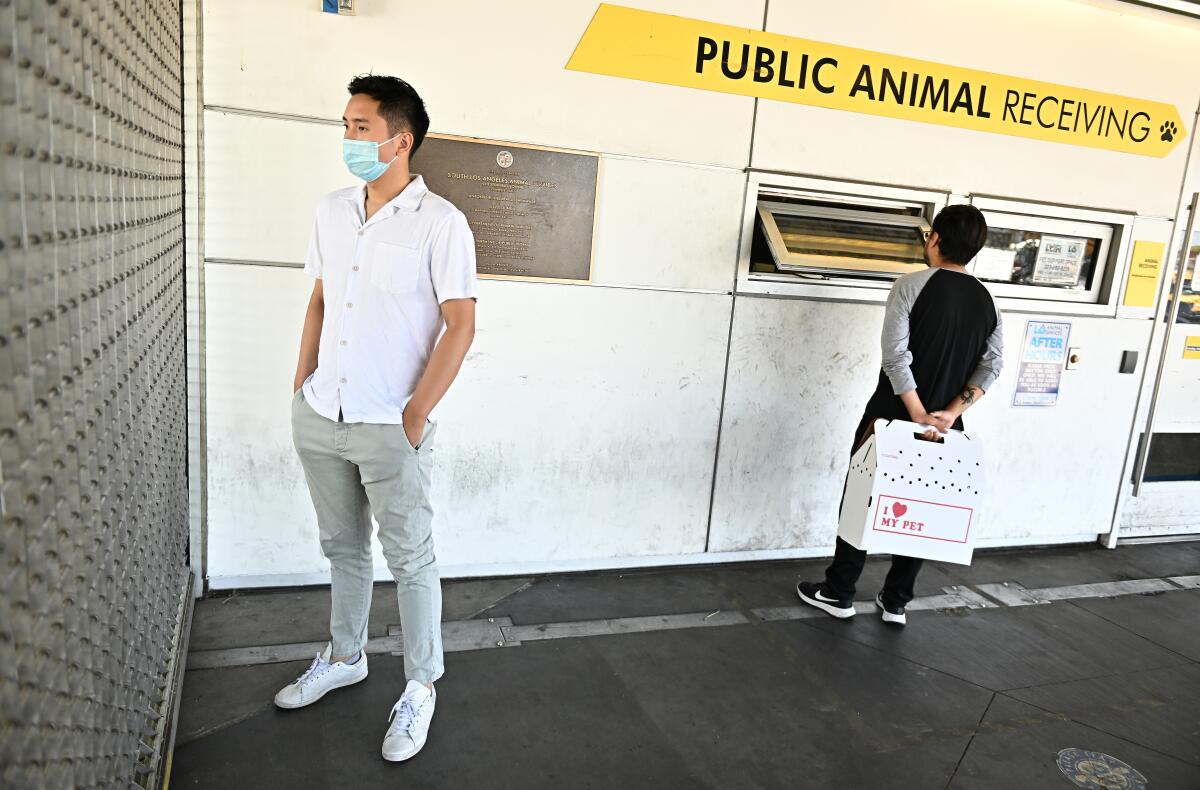
In addition to exercising the animals, volunteers meet shelter visitors, help adopt out the animals, and do laundry and other tasks.
At some shelters, volunteers and city staff work well together, both groups told The Times. At other facilities, some volunteers face criticism they’re overstepping their roles, while volunteers allege some staff don’t care about animals.
Former Animal Services staffer Carolyn Almos, who oversaw the city’s volunteer program, said Animal Services has an “almost impossible job” with its limited resources.
However, “too often, the volunteers come into an environment that is not welcoming,” said Almos, who left earlier this year to work at Ventura County Animal Services. She declined to elaborate.
Larry Gross, president of the Board of Animal Services Commissioners, said that “if the City Council wanted to allocate funding for dog walkers, that would be great. But they are not. And so, all the other staff are taking care of the animals inside the shelter.”
“It’s all a matter of funding and resources,” Gross said.
Staffing shortages are also affecting the animals following a wave of departures and COVID-19-related absences.
Get the lowdown on L.A. politics
Sign up for our L.A. City Hall newsletter to get weekly insights, scoops and analysis.
You may occasionally receive promotional content from the Los Angeles Times.
“We can’t manage the amount of animals we have,” said an animal care technician, describing how technicians struggle to clean cages, intake animals and more. The worker, who asked to remain anonymous, said the lack of walks reflects the “bigger problem” of the staffing shortage.
On a recent weekday, Jerry Xu scrolled through his phone at the South L.A. facility, waiting to adopt a dog he had previously visited there.
He had made an appointment online to pick up the dog, and checked in with the staff. It had been an hour and no one had checked back in with him. “It’s a little frustrating,” Xu said.
Ramirez said the department expects to hire about 15 to 20 people in the coming months. The department had 300 filled positions and 55 vacancies in March.
In the midst of the shelters’ busy summer months, the city is expecting its dog population to remain high.
Nutmeg, a small, tawny-colored mutt, yelped inside her kennel in South L.A. as volunteers approached. The 1-year-old dog hadn’t been out for a walk in more than 4½ weeks, according to the database.
Taken to the shelter’s yard, Nutmeg took off, circling the perimeter. After 20 minutes, she’d go back to the kennel.
More to Read
Sign up for Essential California
The most important California stories and recommendations in your inbox every morning.
You may occasionally receive promotional content from the Los Angeles Times.
